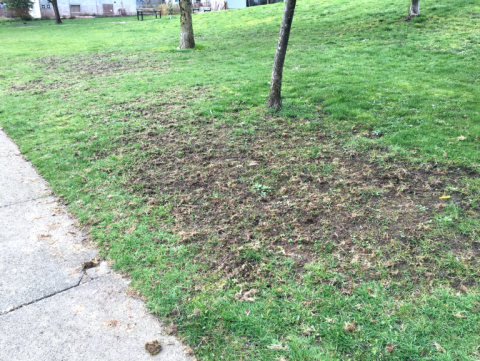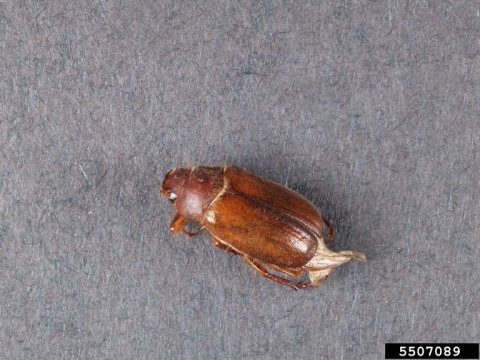
Crows, raccoons and other wildlife may destroy your lawn searching for chafer beetle larvae. Photo: UBC Botanic Gardens.
What is a chafer beetle?
The European chafer beetle is a serious lawn pest. It was introduced to Washington state in 2015.
Why should you care?
Chafer beetle larvae feed on the roots of turf grass. Many animals find the larvae or grubs irresistible. This includes raccoons, skunks, otters (yes, really), crows and other birds. They rip up vast areas of grass one tuft at a time to get to the grubs. In the process, they may totally destroy your lawn.

European chafer beetle larvae look like a sinister alien species. They are about 3/4 inches long with 3 sets of forelegs. Photo: David Cappaert, Bugwood.org.
- Do you think you have chafer beetles in your lawn? Give us a call and we’ll come out to confirm it and report it to the Washington State Department of Agriculture.
- Grow a healthy lawn. Chafer beetles prefer weak and stressed lawns.
- Do not let your lawn go dormant over the summer months. Continue regular watering to keep the lawn alive and healthy.
- We do not recommend you apply any systemic insecticides or other chemicals. Even if the chemicals are “naturally” derived, they can kill worms and beneficial insects.
Tips for a healthy lawn
- Increase mowing height to 2-1/2 inches or more. This produces deeper roots, shades out weeds and holds up better to damage. Cutting the grass short will allow moss and weeds in, prevent good root growth and be less resistant to erosion and compaction.
- Water deeply (about one inch a week) and infrequently. This encourages grass roots to grow more deeply. Frequent shallow watering keeps roots at the surface, rots anything deeper, stunts growth, causes thatch and more.
- Fertilize regularly with organic, slow-release fertilizers.
- Top dress to add organic material and improve soil structure.
- Make sure your lawn gets enough sunlight. Lawns need a minimum of four hours of direct sun each day.
What In Harmony can do

European chafer beetle adults are about 1/2 inch long and resemble Japanese beetles. Photo: Bruce Watt, University of Maine, Bugwood.org.
- Aerate, overseed and top dress the lawn. These treatments bring more air and water into lawn roots, add organic matter and help the lawn grow more thickly.
- Test your soil and add lime as needed to reduce acidity.
- Thin trees to allow in more sunlight.
- Replace lawns in shady areas with groundcovers and other plantings better suited to shade.
- Reseed a damaged lawn with tall fescues, which the beetles do not favor.
- Apply beneficial nematodes. We can apply a strain that will reduce grub populations by about 60-70%. The nematodes are totally safe and nontoxic to people, pets and other insects. Nematodes are tricky to use, however. They must be applied around July when the grubs are most vulnerable, and you must water well before the application and then twice per week for three weeks. Applications may need to be done for more than two seasons.
Chafer beetle is a new pest with a lot of unknowns and we’re learning how to deal with it. Be confident that you are a step ahead partnering with In Harmony Sustainable Landscapes.
Contact us if you have questions about chafer beetles or how our natural lawn care services can help you grow a healthy lawn that will resist beetle invasions..
Find out more
- Why are crows ruining my lawn, aka living with European chafer beetle in Vancouver, UBC Botanical Garden
- European chafer beetle, City of Coquitlam
- European chafer beetle, City of Richmond, BC

I am intersted in where you are finding European chafer. I’ve so far confirmed that larvae have been found at a cemetary in Tukwila and at Evergreen Washelli in Seattle. This weekend it was found in Edmonds. So I’m reaching out to fill in any gaps. I’ll be talking to the Golf Course Superintendents and hope to flesh out more detail before my talk.
Hi Sharon, thanks for asking. We will check with the service techs and let you know.
Come to Normandy Park (just south of Burien)…. parks, schools, most homes have infested lawns. It’s horrible.
Sorry to hear that. Thanks for letting us know.
Come to Kaiser Permanente we have them tearing up our lawn in the front. It’s the second year now this is happening.
Thanks for letting us know. We are sorry they are destroying your lawn. Which Kaiser Permanente facility? Would you like us to take a look at the lawn?
I live in unincorporated King County, with my property line bordering the southern border of Burien. There is much damage in my area, with my neighbors on either side having much of their lawns destroyed. They also rip around the edges of mine (which is mainly moss, due to two huge spruce trees, one in back and one in front, which shades out grass) The only reason they haven’t damaged my yard more is because I scare them off at any chance I get. But I’m not home much of the time, and when I’m away they get more bold. My neighbor to the north re-seeded his front lawn after the devastation, but the crows returned and ripped up the new lawn too. I’m wondering if they are merely looking, but not necessarily finding these larvae, but continue to shred lawns in the constant search?
Across from my house is Cascade Middle School, and the lawns that used to be in courtyard areas between buildings are gone. The crows are now working on the athletic field. The school doesn’t seem to be doing anything.
My address is 11259 10th Ave. S.W. Seattle 98146
My friend in Des Moines, Wa. also has crows ripping up grass on his property, and we’ve seen a lot of rip-up along Marine View Drive, in planting strips adjacent to sidewalks.
I don’t have any kind of working camera or phone camera.
Wow! So sorry to hear about the damage. Here is a link to an infographic I found about the lifecycle of the chafer beetle. It says the grubs feed all winter in frost-free areas. They are most active beginning from March to May. So it may get worse. https://www.denbow.com/life-cycle-of-the-chafer-beetle/
And Marcia, would you like us to give you an estimate for services? Perhaps to replace some of the moss lawn with other plantings that will be healthier in your shady yard? You can fill out a contact form here: https://inharmony.com/contact/message/
I live in West Seattle near the intersection of Marine View Dr. SW and 109th. My yard and many neighbors in the area have been torn up this spring by crows hunting for grubs. Last year I only saw a few yards like this so I think the problem is getting worse. It seems like they are attacking the more maintained yards. Neighbors that let their grass go dormant over the summer don’t seem to have a problem (that is just an observation).
Thanks for letting us know. Sorry for the growing problem!
I have found two in my yard without really trying. I live in north Marysville.
Another question. Can I get samples and photos from any new accounts (no identifying info unless desired). I am free most days to gather any samples found.
Hi Sharon, Ladd will have the techs ask clients about that.
Some friends asked me about a torn-up lawn in West Seattle. The photo they sent looked exactly like chafer beetles. Unfortunately, I no longer have the photo. It was their neighbor’s lawn. I asked them about the location and about possible photos and samples.
Annette
Found one in my garden I live in Lewis county about 10 miles outside of Toledo WA. The one I found was over a inch long. So their not just in the Seattle area.
Sorry to hear that! Thanks for letting us know. We will pass it along.
I have found two in my yard without really trying. I live in north Marysville.
Sorry to hear that! This is a nasty critter.
The best thing you can do right now is to keep watering your lawn. Summer watering is critical to manage this pest. A healthy, robust lawn will be better able to survive the invasion.
Here are more tips on how to manage chafer beetles. Read the first one about what to do in June. It still applies now.
https://inharmony.com/managing-chafer-beetles-what-to-do-in-june/
https://inharmony.com/managing-chafer-beetles-what-to-do-in-september/
https://inharmony.com/how-to-manage-chafer-beetles-what-to-do-in-march/
There are three large scarab beetles that could be found: 1) white grubs or 10-lined June beetle, 2) Japanese beetle, a bit smaller and not here yet but closing in (they are found in Portland, Vancouver BC and no Sunnyside and Grandvirw in WA, and 3) European chafer. Still limited in distributtion. I am questioning my id of the Edmonds site because I didn’t see them and becuase they seemed to be associated with the roots of a pine which is more typical of white grubs. So that one is a question mark. The only way to tell them apart is by looking at the hind end of the larvae.
**European chafer. Pest Alert bulletin with some look-alikes to help distinguish chafer from other lawn pests
https://s3.wp.wsu.edu/uploads/sites/2070/2013/12/European-Chafer.pdf
**Bring samples to your local Extension office or the Washington State Department of Agriculture. Report sightings at
1-877-9-INFEST or PestProgram@agr.wa.gov.